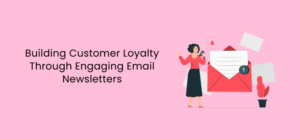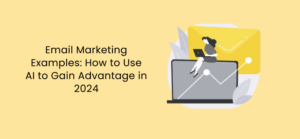Businesses with overflowing email inboxes often have a progressive decrease in productivity due to how much time they spend sending the same emails. The same happens when they receive them, as it can make it difficult to respond in time. Fortunately, you can address this problem with email automation.
When you automate your emails, you free up a lot of time for more important work, as you can set up automated email responses. Since you have time for doing other things, you can use it to improve efficiency and get overall better results.
People often think this is something too difficult to do, but it’s as simple as identifying tasks for automation, using email templates, harnessing the power of triggers and workflows, scheduling emails for optimal timing, and tracking automation performance. Does it seem like a lot? Don’t worry; we are here to make it all simpler.
Dive into this page to learn how to automate your emails in five simple steps!
1 – Identify Tasks for Email Automation
The first thing you need to do before sending your professional email is identify the email-related repetitive tasks you need to automate. You can’t automate things that need your attention but more general tasks that don’t need as much information or focus. We are talking about welcome emails, appointments, reminders, follow-ups, data entry, and more.
There are many ways to analyze which tasks are fit for automation. First, look for repetitive tasks you normally have to do daily. After that, check how often you need to do these tasks and how much time they take at the end of the day. You will be amazed by how much time a day you spend doing the same things, but your job doesn’t end here.
Before trying to automate those tasks, analyze how complex they are. If they are not simple enough to be fit for automation or require human judgment, you should still do them. Look for automation tools that can do the exact job you are doing, and then test and refine their results.
We know it can seem like a nuisance to repeat this process for all the repetitive tasks you do daily, but that will save you a lot more time in the long run. Since that will improve your productivity, it will increase your sales too.
2 – Utilize Email Templates
Now that you know how to identify the tasks you should automate, let’s go deeper: how to automate emails. Follow-up, sales and marketing, welcome, and goodbye messages often say similar things, so spending valuable time of your day writing the same is a waste of your work schedule.

Fortunately, you can save yourself the hassle of doing that by using email templates. They are pre-written messages you can customize and use all the times you need to. Creating these templates is easier than you may think, and you can do it on mainstream platforms such as Gmail and Outlook or within email marketing tools. There are quite a few popular ones to choose from.
Pre-written templates eliminate the need to start from scratch each time you need to write a similar email. This can significantly reduce the time and effort it takes to compose emails, especially for frequently repeated tasks.
You can easily customize templates with specific details and information, saving you the hassle of rewriting the same content over and over again.
3 – Harness the Power of Triggers and Workflows
Understanding how triggers and email marketing workflows work is essential for automation. When we talk about triggers, we mean actions or situations that activate the automation protocol you preset and, therefore, the actions you want it to do. You can, for example, use a date as a trigger to send a bunch of emails you wrote weeks ago.
As for workflows, they consist of automated sequences of actions done by automation tools. Let’s say you have an exit-intent trigger that automatically shows coupons and promotions and redirects the customer to another page; all those actions are part of an automated workflow.
Abandoned cart and order confirmation emails, birthday greetings, and tracking updates are excellent examples of actions that trigger that kind of system. You can build all the workflows you want with email automation tools, such as Zapier.

This app manages the concept of “Zaps,” which are workflows that connect your apps through specific triggers. When you use Zapier, you only need to set a trigger and the events it will cause among all your apps. After you program the zap, you only need to publish it, and the system will run itself every time the trigger action happens.
Check this out: 5 Automated Workflows To Generate More Leads Using Poptin & Zapier
4 – Schedule Emails for Optimal Timing
Email marketing campaigns are not only about sending emails but also about sending them at the right time to optimize customer engagement. It’s proven that emails, popups, and social media posts don’t have the same effect on customers all day, so marketers often study what the right time is for each post or message.
If your target audience is adults between 25 and 40 years old, it’s useless to set an automated email at 10 in the morning, when most of them are working. However, scheduling it for 2 in the afternoon while people are on breaks might get you much more engagement. There are many email scheduling tools on the market to help you with scheduling.
Most people use this platform for email marketing since it analyzes when your clients are prone to read your email and focus on what it says. When you sign up for it, you need to write the email you want and set the date and time when you want to send it.
We recommend choosing the time for sending emails based on your target audience, different time zones, open rates, and important holidays. If you are not sure what option to try, use A/B testing to check which time gives you better results.
Check this out: 7 Reasons You Should A/B Test Your Email Campaigns (+ What Elements To Test)
5 – Track and Analyze Automation Performance
Your job is not done once you learn how to automate your emails since you still need to track and analyze your automation performance. People still need to check the results they get and make the right adjustments to get the most advantage they can from this tool. It’s useless to automate all your tasks if what you are doing is slowing down your profits.

Open, click-through, and conversion rates are essential metrics to consider when tracking how email marketing campaigns are doing. It’s really important to understand your average user’s behavior to know the adjustments you should make.
You should make adjustments based on A/B testing, audience segmentation, personalization, feedback, and the metrics we mentioned. Many email marketing platforms help you do this and automate this process, so you can try that if you want or work with a marketing team.
Sometimes, you don’t have to make changes because your initial efforts were wrong but because they are not as effective as before. The efficiency of your campaign will change based on world events, so keep that in mind before doing anything.
Conclusion
All the steps mentioned before are simple to undergo and offer top-notch results. When you identify your tasks, you acknowledge the problem; when you use templates and learn how to use triggers, you are simplifying your job; when you schedule emails, you are working with preparation; and when you track and make adjustments, you are optimizing your campaign.
If you want to take your business to the next level, we recommend you start using these tips as soon as possible. You will see the benefits of it in no time. There are more advanced automation and marketing tools, such as CRM data analysis, re-engagement strategies, web tracking, and more, but you’ll learn about that after you master what you read on this page.




